
14 minute read
Ten Ways to Foster Creativity
By Young B. Choi
There are many problems that appear as the world becomes more and more complex and technology develops day by day, but among them, creativity is quite important and is being discussed a lot. Opinions are often expressed on how to cultivate, achieve, and train for creativity. This is a simple issue.
Advertisement
As I have been in the teaching profession for a long time, I have done a lot to cultivate creativity in my own way. First, I tried to cultivate my own creativity by myself. I made a lot of attempts and efforts in that regard. If we think from the problem of making a definition of creativity, it is an endless problem, but in order to develop creativity, I want to describe some of my own methods here.
— First, have curiosity and passion
in everything. This is the most important. If there is no enthusiasm or curiosity regarding a certain thing, I think it is not very likely that the work will be interesting or that creativity will rise.
— Second, frequently ask, “Why is that?” when analyzing any work or
phenomenon. If you do this, you will be able to know the reason behind the phenomenon, or its grounds, so that you can deal with similar phenomena or work later. This curious frame of mind can be used for understanding and practicing creative work or research.
— Third, get out of the ordinary
frame of thought quickly. I believe that if you think and act like others, your chances of fostering your creativity are low. A variety of angles and viewpoints in which one’s new self is born can be generated by boldly deviating from the standard way every single day. As the Apple slogan goes, “Think Different.”
— Fourth, read a lot of books to have diverse, indirect experiences.
Books are summarized by experts in each field in their own way, including their own experiences, knowledge, and feelings. Because of this, through reading you can learn what you want to find out in a short period of time and then use that as a basis for thinking creatively later. In other words, you can use whatever you learn from books, so read regularly.
— Fifth, take a lot of trips and constantly stimulate yourself
intellectually. When you travel, you will constantly plan, eat, sleep, and walk in a variety of new environments until you have successfully completed your journey. You will mix with diverse groups of people, naturally feel and learn many things, and receive fresh stimulation. In the future, this travel experience will help stimulate your creativity.
— Sixth, develop the habit of taking notes. Even if a good idea is contained in your head, there is no use for it if it stays there, so whenever a good idea comes up, it should be recorded immediately. Then it can be utilized well if it is needed later. Great ideas should not be forgotten.

— Seventh, study and exchange ideas with people from various fields outside your field of study to

In Conclusion
In my own way, I have briefl y introduced ten ways to cultivate creativity through experience. As all work requires constant eff ort, even in the process of strengthening creativity, these desirable methods should be practiced continuously and repeatedly throughout life. I think it is possible to develop stronger mental powers to nurture creativity by practicing.
Th e following quote about the creativity of Albert Einstein (18791955), a world-renowned physicist and philosopher, touches the heart: “I have no special talents. I am only passionately curious.”
broaden your knowledge. Even if something is not related to your fi eld of interest, you learn a lot of things that you didn’t expect to by talking and interacting with people in those fi elds. By combining those new ideas with the fi eld you are most familiar with, you can create your own ideas that are more original and diverse.
— Eighth, with a critical eye, read interesting websites, newspapers, and magazines, especially about
new global trends. Th e media should be used to continuously grasp current issues and projects related to one’s area of interest. Try to keep abreast of what problems are currently emerging and topics that are actively being discussed. It is necessary to pay attention to these changes.
— Ninth, think as much as possible during quiet time in a space where
you are alone. In a noisy place, it is very easy for your thoughts to become dispersed. If possible, forget about everything, even if for just a short period of time during the day, and try to concentrate on your own thoughts. If you spend quiet time focusing on a problem or issue, this can lead to a more creative solution.
— Tenth, treat your brain to frequent walks, enjoyable music,
and artistic endeavors. Walking is well known as very good exercise that gives good stimulation to the brain, and music and art are also good tools to stimulate the brain. Recent scientifi c experiments and research results have proven this to be true. Facilitating the activity of the brain, which is the core part of the body responsible for creative thinking, is very important. Th is healthy brain stimulation is very desirable for creative thinking.
The Author
Young Choi is a professor in the Department of Engineering and Computer Science at Regent University in Virginia, USA. He is serving KAUPA (Korean American University Professors Association) as the 14th president since 2020. Dr. Choi enjoys essay writing, drawing, and international poem composition and translation. Email: ychoi@regent.edu


Wedding During the Pandemic

A Time for Love
By Kim (Hillel) Yunkyoung


It has been over a year already, since COVID-19 changed almost every aspect of our daily lives. And one of the biggest changes is that we aren’t supposed to be gathered together. Th erefore, we are using all kinds of online media such as Zoom to communicate with each other and feel as if we are together. But at times, we still need to meet face to face, especially for events like weddings and funerals. Th ese are the two events in which people feel obligated to meet in person regardless of the circumstances. However, the coronavirus does not care about either circumstance or time. If it is spreading, it spreads. Th e role of the government kicks in with its regulations at this point. So the wedding business is one of the fi elds that has suff ered the most.
In the midst of all of these chaotic moments, my closest friend Nick got married. On January 18, 2021, there were 386 COVID-19 confi rmed new cases countrywide, and the social distancing level was 2.5. Only 50 participants were allowed to attend gatherings such as weddings, but they preceded with their wedding ceremony anyway.
It was all about masks, but as you can see, smiles were everywhere. It was all about joy and happiness. Th e couple was so sad that they could not invite more people to their wedding ceremony. However, since there were fewer people gathered, they could focus more on each other. Overall, despite all the agonies during the wedding preparations due to constant changes in the COVID-19 situation, they feel blessed. COVID-19 might have kept families and friends apart but not the love between them.
The Photographer
Kim (Hillel) Yunkyoung is a priest in the Anglican Church and also a portrait photographer. More of his pictures can be found on Instagram: @hillelkim


▲ In Jesus’ name, Amen.
Yes, it is a happy day.

▲ January 18, 2021: Nick rolls out to the hair salon.

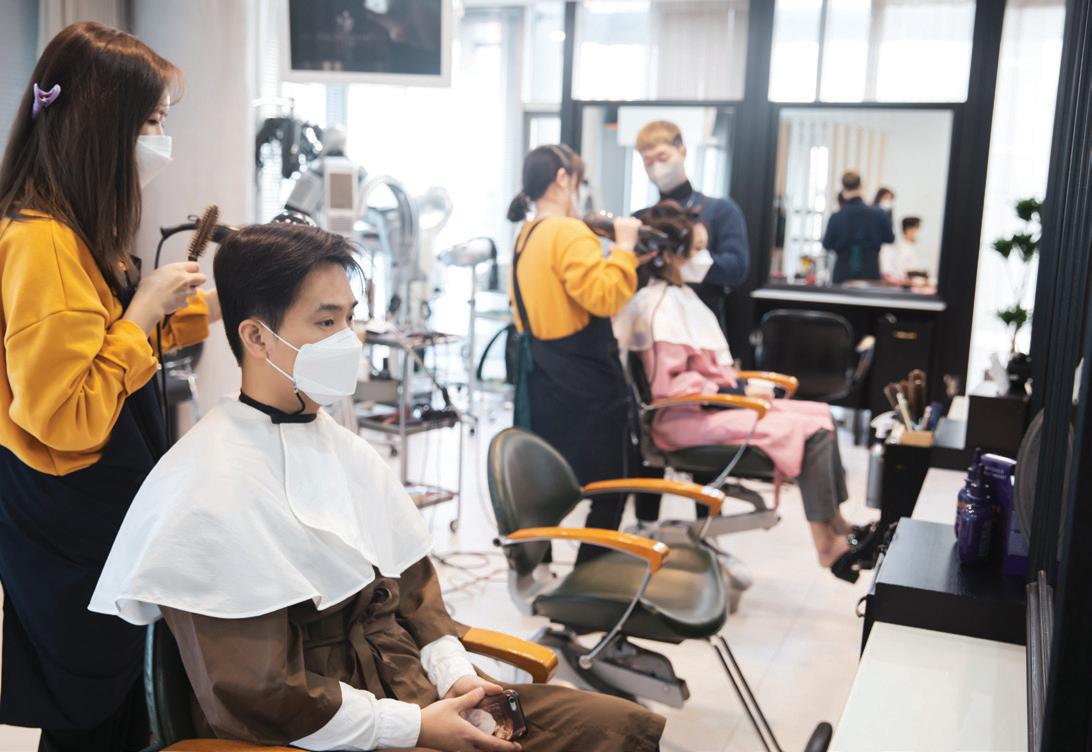

▲ Mask, mask, and masked.
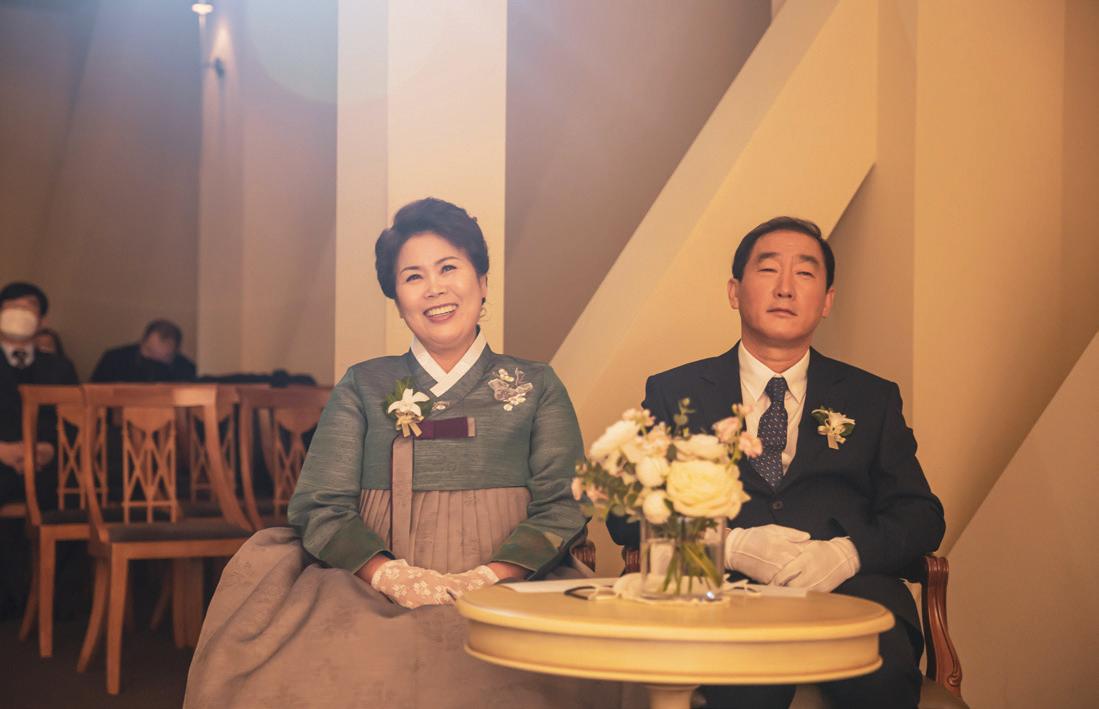


Happy parents
We just got married!
All set, ready to celebrate.
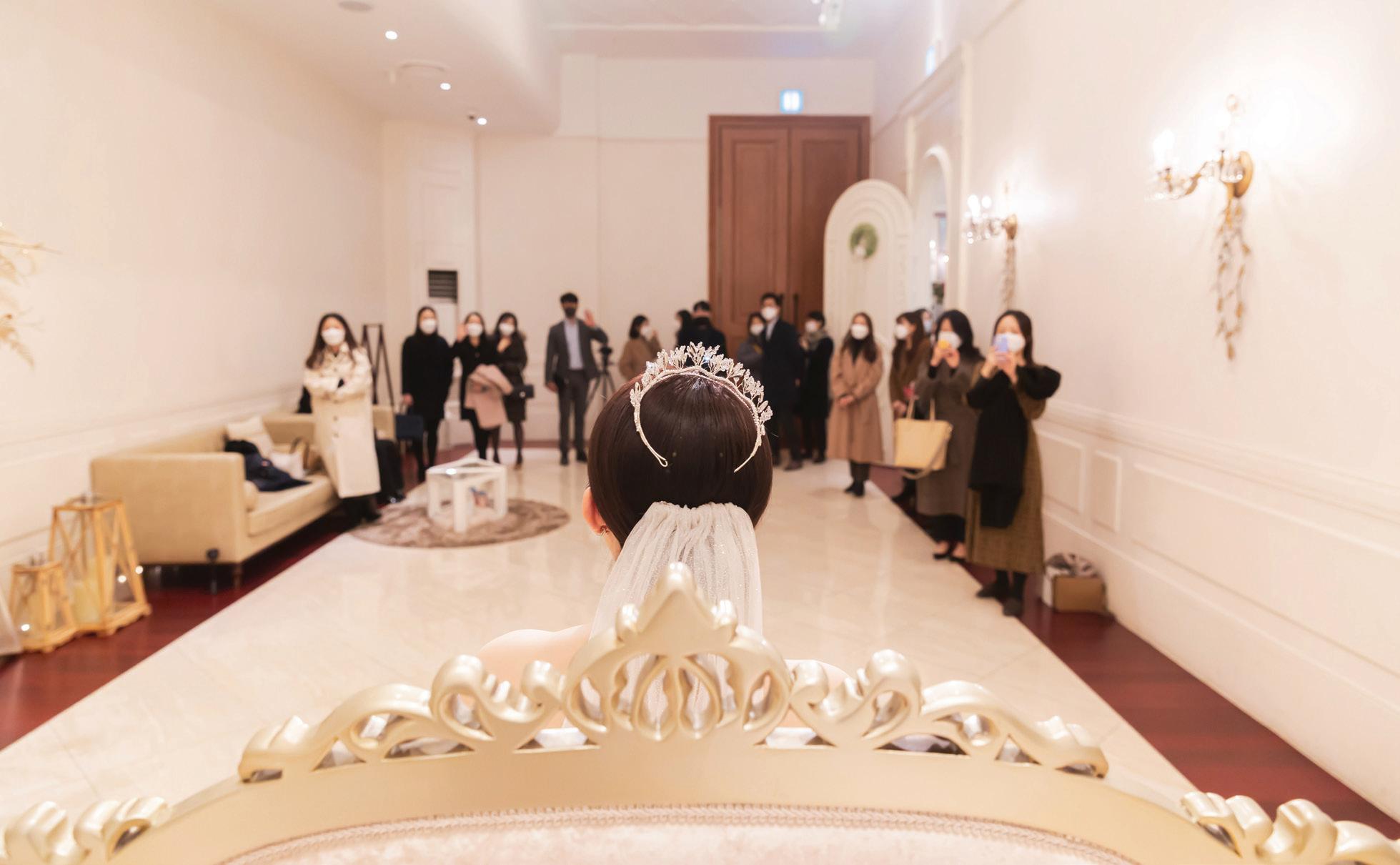

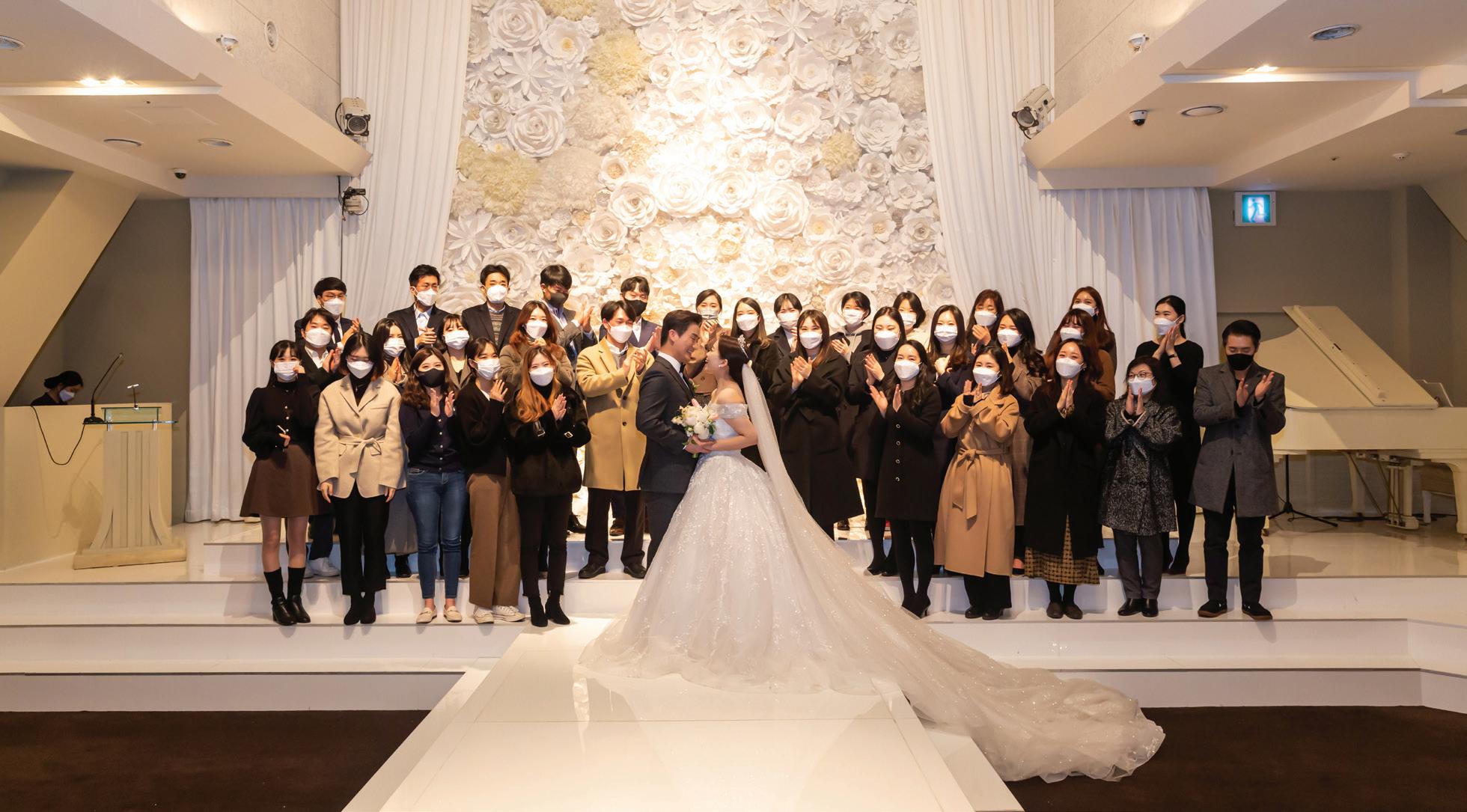
Mask, mask, and more masks.
Goedam: Hong Won-ki’s Netfl ix Series
Transnationalism and Ghostly Korean Urban Legends
Ayoung girl in the restroom of her school realizes that there is no more toilet paper. Suddenly, she can hear a scary voice coming from nowhere and asking her, “Do you want blue or red paper?” Th is reference to a Korean urban legend is found in Gong Jiyoung’s novel Bonsuni Eunni (봉순이 언니),1 which is the Japanese counterpart to a similar tale known as Aka Manto (Red Cape).2 Korean literature and cinema actually share some folk tales with surrounding countries: Many studies point out the links between Korean and Japanese urban legends on the one hand – the powerful symbolism of hair, for example3 – and renowned fi lmmakers on the other hand, like Miike Takashi and the late Kim Ki-duk, who unfortunately died of COVID-19 on December 11, 2020.4 Pivotal concepts developed across pan-Asian urban legends (e.g., school toilets, taxi drivers, mirrors, elevators, Ouija, and the internet) belong to what one Californian anthropologist refers to as “deep structure,” as opposed to locally adapted “superfi cial structure,” which is the diversity within historical content with respect to vernacular traditions.5
What Is an Urban Legend?
Th e American folklorist Jan Harold Brunvand defi nes urban legend as a “subclass of folk narratives (…) that – unlike fairy tales – are believed, or at least believable, and that – unlike myths – are set in the recent past and involve normal human beings rather than the ancient gods or demigods.”6 David Schaefer, who graduated in Japanese literature from Columbia University (New York), wrote a monograph in 1990 on Japanese urban legends and ascribed to them six main characteristics: Th ey are “true,” primarily oral, short, linked together, unusually detailed, and cannot be traced to reliable witnesses.7 Th is last feature explains why a great many of these tales deliberately include spatial and/or temporal vagueness. For example, “once upon a time,” “long ago,” or “in a certain place” are the fi rst words of many Korean,8 Japanese,9 Vietnamese,10 and Siamese11 tales.
Goedam
Hong Won-ki’s (홍원기) 2020 Netfl ix Series Goedam (괴담)12 (Figure 1), also known as Doshi Goedam (도시괴담), is an anthology of Korean ghost urban legends
By Régis Olry
featuring eight short episodes (between 8 and 15 minutes each): “Crack” (틈), “Destination” (목적지), “Special Guest” (합방), “Curiosity”(장난), “Red Shoes”(맞춤신발), “Dimension”(엘리베이터), “Th reshold” (문지방), and “Birth” (생일). As usual in Asian ghost movies,13 many actresses in Goedam are K-pop stars or top models: SeolA (Kim Hyeon-jeong) of the group Cosmic Girl and the model Lee Hyun-joo (former member of the group April) in Episode 4 serve as examples.
Let us go through some of these eight episodes.
Th e second episode (“Destination”) shows a young woman dressed all in white who takes a cab by night on a lonely road (Figure 2). But when she takes off her sunglasses, the taxi driver realizes that his passenger actually is a holloweyed ghost. Th is story refers to a Korean urban legend involving such a ghost seen in foggy weather, northwest of Seoul on the Jayuro Highway between Goyang and Paju. Th is kind of strange encounter by taxi drivers also occurs in Japan, especially near Midoro-ga-Ike Lake of Kyôto. In her 2016 Tohoku Gakuin University thesis, sociologist Yuka Kudo discovered that seven percent of Japanese taxi drivers claimed to have had at least one ghost as a passenger.14 Th e links between ghosts and cab drivers are also the core of the 2005 Th ai movie Taxi Tonight.
Episode 4 (“Curiosity”) takes place in a high school. A girl is chased by a ghost aft er having found a creepy doll in her friend’s locker. Frightened, she hurtles down the stairs but always fi nds herself back on the same fl oor: She is trapped in a time loop (an implied reference to the impossible object known as the Penrose stairs). Th e same phenomenon occurs in the celebrated 2004 Th ai movie Shutter, when photographer Tun runs away from
Figure 1. Movie poster of Hong Won-ki’s Goedam.
his ex-girlfriend Natre, who became a vengeful ghost aft er having been raped by Tun’s friends. Th is episode also refers to another aspect of “deep structure” in urban legends: the spider-woman. Actually, the way the ghost crawls in the corridor and on the stairs (Figure 3) on the one hand, and the increase in the number of her pupils (most spiders have eight eyes) when she comes near her prey on the other hand, lead us to acknowledge this ghost as a Korean counterpart to the so-called Kumo Onna, the famous spider-woman of Japanese folklore.
In Episode 5 (“Red Shoes”), a bullied girl who had committed suicide (when her legs were crushed by a truck) comes back as a ghost in order to appropriate new legs. When she stands up on her hands, her teacher sees that the ghost, cut in two, has only its upper part left (Figure 4): She explains that Hye-su’s (another schoolgirl) legs were not correct and then encourages the ghost to take the teacher’s legs instead. Th is creepy creature also belongs to Japanese urban legends such as Teke Teke,15 the young Kashima Reiko who was cut in two by a train in Muroran, a coastal town in the south of Hokkaidô Island.
Goedam (including the soundtrack of its trailer) is a real masterpiece that will delight lovers of ghostly urban legends. Some viewers have pointed out the recurring lack of explanation: the uncertain status of the creepy doll in the locker of Episode 4, for example. But is not the lack of explanation precisely a sine qua non component of these kinds of legends?
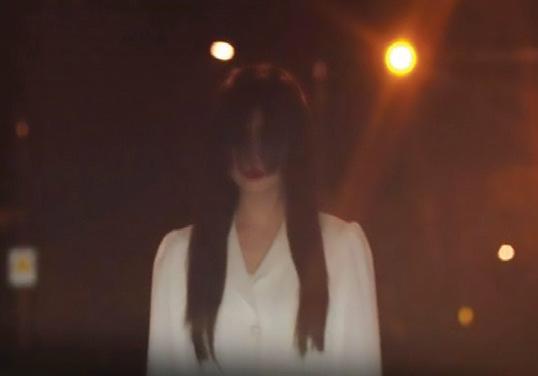
Figure 2. Joo Bo-bi (주보비) as the ghost who takes a taxi (Episode 2).
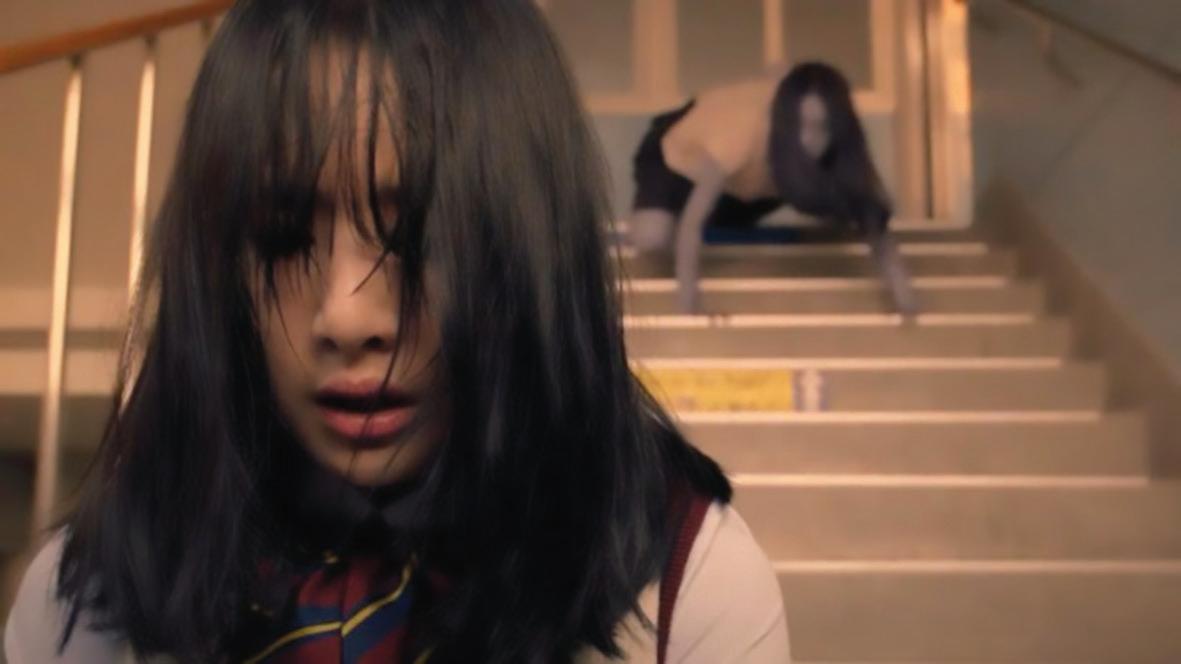
▲ Figure 3. SeolA (설아) as Min-yeong (foreground), the student trapped in a time loop (Episode 4).
Figure 4. Jin-gyeong’s ghost about to take her teacher’s legs (Episode 5).
2
3
4
5
6
7
8
9
10
11
12
13
14
15 Gong J. (2018). Ma très chère grande sœur [French translation of Bonsuni eunni]. Arles, Philippe Picquier, p. 71. Devlin, T. A. (2018). Aka Manto. In Toshiden: Exploring Japanese urban legends (pp. 83–87). Independently published. Byrne, J. (2014). Wigs and rings: Cross-cultural exchange in the South Korean and Japanese horror fi lm. Journal of Japanese and Korean Cinema, 6(2), 184–201. Rawle, S. (2009). From Th e Black Society to Th e Isle: Miike Takashi and Kim Ki-duk at the intersection of Asia Extreme. Journal of Japanese and Korean Cinema, 1(2): 167–184. Spiro, M. E. (1978). Burmese supernaturalism (p. xviii). Institute for the Study of Human Issues (Philadelphia, PA, USA). Brunvand, J. H. (1981). Th e vanishing hitchhiker: American urban legends and their meanings (p. 3). W. W. Norton. Schaefer, D. (1990). Urban legends and the Japanese tales (pp. 8–13). Th e Institute for Cultural Research (Tunbridge Wells, England). Carpenter, F. (1973). Cinderella. In Tales of a Korean grandmother (pp. 117–124). Tuttle. Mayer, F. H. (1984). Stepchildren stories. In Ancient tales in modern Japan: An anthology of Japanese folk tales (pp. 44–60). Indiana University Press. Pham, D. K. (1989). Légendes des terres sereines (p. 7). Mercure de France. Le May, R. (1970). Siamese tales old and new (p. 123). Arthur Probstein. A 1968 ghost movie directed by Jeon Jo-Myeong had also been called Goedam. Th e Japanese top models Hashimoto Ai and Nakama Yukie in 2000 Ring 0: Birthday and 2012 Sadako 3D, respectively; the Japanese member of AKB48 Matsubara Natsumi in 2012 Kotsutsubo; and the Taiwanese top model Shu Qi in 2004 Th e Eye 2, among many others. Kudo, Y. (2016). Yobisama sareru reisei no shinsagaku: 3.11 sei to shi no hazama de. Kadokawa Shoten. Devlin, T. A. (2018). Teke Teke. In Toshiden: Exploring Japanese urban legends (Vol. 1, pp. 35–39), Independently published; and Devlin, T. A. (2019). Sky resort. In Toshiden: Exploring Japanese urban legends (Vol. 2, pp. 23–24). Independently published.
The Author
Régis Olry, M.D. (France), is professor of anatomy at the University of Quebec at Trois-Rivieres (Canada). In the early 1990s, he worked in Germany with Gunther von Hagens, the inventor of plastination and the BodyWorld exhibitions. He currently studies the concept of Asian ghosts in collaboration with his wife who is a painter (see www. gedupont.com).











